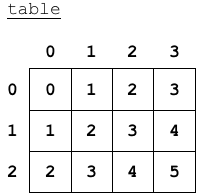|
|
|
Often the data a program uses comes from a two-dimensional situation. For example, maps are two-dimensional (or more), the layout of a printed page is two-dimensional, a computer-generated image (such as on your computer's screen) is two-dimensional, and so on.
For these situations, a Java programmer can use a two-dimensional array. This allows for the creation of table-like data structures with a row and column format. The first subscript is a row index in a table while the second subscript is a column index in a table. Here is example code, in Sample Code 23-1, including a diagram of the array table.
Sample Code 23-1
int[][] table = new int[3][4];
int row, col;
for (row = 0; row < 3; row++){
for (col = 0; col < 4; col++){
table[row][col] = row + col;
}
}

-
Two-dimensional arrays are objects. A variable such as table is a reference to a 2D array object. The declaration
int[][] table;
defines a table that holds a reference to a 2D array of integers. Without any further initialization, table holds the value null.
-
The declaration
int[][]table = new int[3][4];
defines a table that holds a reference to a 2D array of integers, creates an array object of 3 rows and 4 columns, and puts the reference in table. All the elements of the array are initialized to zero.
-
The declaration
int[][] table = { {0,0,0,0},
{0,0,0,0},
{0,0,0,0} };
does exactly the same thing as the previous declaration (and would not ordinarily be used.)
-
The declaration
int[][]table = { {0,1,2,3},
{1,2,3,4},
{2,3,4,5} };
creates an array of the same dimensions (same number of rows and columns) as the previous array and initializes the elements to the given values in each cell.
-
If no initializer is provided for an array, then when the array is created, it is automatically filled with the appropriate values: zero for numbers, false for boolean, and null for objects.
-
Just as with one-dimensional arrays, the row and column numbering of a 2-D array begins at subscript zero (0). The 3 rows of the table are numbered from 0...2. Likewise, the 4 columns of the table are numbered from 0...3.
-
The array table is filled with the sums of row and col, which is accomplished by Sample Code 23-2 (see below). To access each location of the matrix, specify the row coordinate first, then the column:
table[row][col]
Each subscript must have its own square brackets.
-
The length of a 2D array is the number of rows it has. The row index will run from 0 to length -1. The number of rows in table is given by the value table.length.
Each row of a 2D array has its own length. To get the number of columns in table, use any of the following:
table[0].length
table[1].length
table[2].length.
There is actually no rule that says that all the rows of an array must have the same length, and some advanced applications of arrays use varying-sized rows. But if you use the new operator to create an array in the manner described above, you'll always get an array with equal-sized rows.
-
The routine that assigned values to the array used the specific numbers of rows and columns. That is fine for this particular program, but a better definition would work for an array of any two dimensions.
Sample Code 23-2
int[][] table = new int[3][4];
int row, col;
for (row = 0; row < table.length; row++){
for (col = 0; col < table[row].length; col++){
table[row][col] = row + col;
}
}
In Sample Code 23-2, the limits of the for loops have been redefined using table.length and table[row].length so that they work with any two-dimensional array of ints with any number of rows and columns .
|


